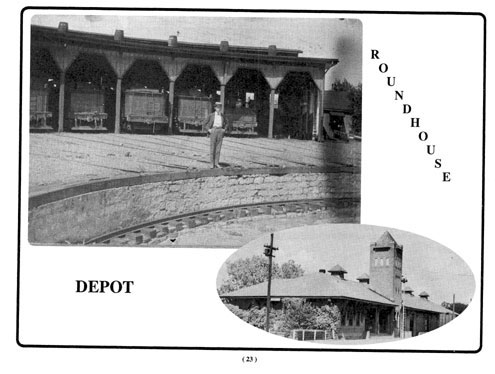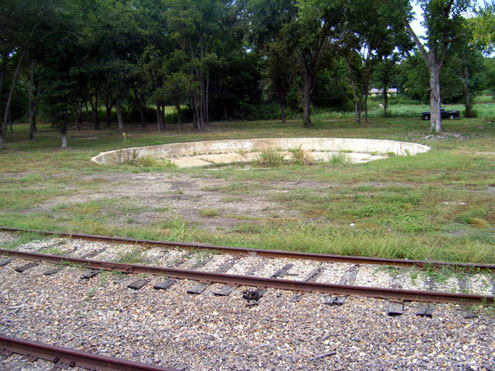What I didn’t include in my first piece were details on just how lively Sherman’s response became, voiced mainly in editorials in Sherman’s leading newspaper at the time, the Sherman Daily Register. I feared that too many details about Sherman’s anger would overshadow the telling of the history of the roundhouse. Besides, that anger makes for an interesting story on its own.
The overall attitude of Sherman city leaders in the wake of losing the roundhouse was perhaps summed up in an editorial that appeared on page one of the August 5, 1886 Daily Register: “The Texas and Pacific has, within the past three years, struck this city some pretty tough licks . . . .”
Though still hurting from those “pretty tough licks,” there is evidence that Sherman intended to repair at least one bit of damage – she intended to get the Texas & Pacific roundhouse, and the division station status that went with it, back.
Newspaper clippings show that the arguments for Sherman and against Bonham began in earnest in late 1886 and carried into 1887. They mostly centered around the availability of water, a much needed item for the steam locomotives of the time. Sherman was developing a good waterworks system while Bonham was struggling with old, inconsistent wells.

City leaders strongly believed that if a first rate water system was developed, the chance of getting the roundhouse and division station status returned to Sherman was excellent.
The Dallas Morning News of August 17, 1886 reported the leaders of Sherman as believing that the “divisional station of the Transcontinental division of the Texas and Pacific Railroad is a plum worth reaching for . . . .” It further reported that “it is now thought by those who have an opportunity to know that the roundhouses, shops, etc., which were taken to Bonham a little over two years ago will be brought back to Sherman in case a good supply of water is found . . . .” (It should be noted that often the papers used the term roundhouses in stead of the more appropriate roundhouse.)
The News piece also stated that a “prominent railroad man to-day, in a conversation with a reporter, said that he knew that if a good water supply was secured . . .” Sherman would get the roundhouse and shops back.
Sounding the same theme, the Sherman Daily Register of August 27 reported Sherman leaders were still optimistic “that if water can be secured the Texas and Pacific roundhouses will be brought back to [this] town . . . .”
Sherman leaders were sure they had the edge over Bonham, and it was time to sound the trumpets. And the loudest trumpet was the newspaper.
The literary assault launched by the Sherman Daily Register (SDR) against Bonham is best put into three categories: 1.) sound arguments based on reason and facts; 2.) subtle, one-line reminders; and, 3.) down right cheap shots that are humorous when read today.
First, the sound arguments.
A lengthy editorial containing seven reasons why the division station should be returned to Sherman appeared on page one of the January 22, 1887 SDR. Among them were: Bonham’s lack of water, Sherman’s good roads, T & P owning plenty of land in Sherman, etc. The editorial concluded: “With these reasons laid before the management of the [railroad] in a proper manner, and with a material influence to back them, will accomplish the desire of Sherman to regain the round house and divisional shops . . . .”
One week later the January 29 issue argued that the “divisional facilities at Bonham are being neglected” while Sherman’s rail yards were being improved. It concluded: “The facts are too apparent. Sherman is the proper place for the divisional station, and out of eternal fitness of things, has grown the intention to put it back here.”
The SDR of April 15 noted: “Ever since the Transcontinental division between Sherman and Texarkana has been laid with steel rails, and the water gave out at Bonham, [T & P] officials have fully realized the mistake they made in taking the divisional terminus away from Sherman and putting it at Bonham . . . .” It further argued that Texas and Pacific owned “enough ground in this city upon which to build round houses, shops, etc. . . . .”

The April 18 SDR argued that there was “no water at Bonham while a system of waterworks is just about completed here.”
The April 25 issue noted that railroad employees, referred to as “trainmen,” were “talking of the proposed change of base of divisional operation from Bonham [to] Sherman, and are glad of it for this city has always been a favorite point . . . .” The April 27 issue reported that the “railroad men on the Transcontinental division of the Texas and Pacific all want the round house, etc., brought back to Sherman.”
The same was also reported in the May 6 SDR.
Finally, the May 11 issue noted that the rail yards in Sherman were being inspected by Texas & Pacific officials. It noted that improvements could mean a return of the division station to Sherman, concluding: “There is much to be gained by getting this divisional station back to its original place, and the REGISTER trusts no time will be lost.”
Intermingled with the reasoned arguments were the occasional one-line reminders. A couple of examples include the April 7 SDR : “The divisional station of the Texas and Pacific should be brought back to Sherman from Bonham;” and the April 22: “Bonham [doesn’t] have the requisite amount of water to maintain the division.” Such reminders also appeared in the April 27, May 4 and May 5 issues, and two were in the May 10th as well.
Perhaps the liveliest reading of all came in the form of editorials that were downright cheap shots. Every once in a while the editor(s) at the SDR abandoned reason and took the literary gloves off.
The March 23 issue noted: “Bonham, the present divisional station of the Texas and Pacific railroad, is a small and insignificant town, twenty six miles east of Sherman . . . .” It further noted that Bonham was of “no consequence” as a “railroad center.”
“Bonham,” the April 18 issue argued, “is of no great commercial importance, and the amount of yard work necessitated for the successful carrying out of local work is not great . . . .”
Saving the harshest blow for last, and commenting on the vastly important water issue, the SDR of May 1, 1887 noted:
A Bonham correspondent to the Fort Worth Gazette gets excited, and says there is more water at Bonham than any place between Whitesboro and Annona. There is a pond a few miles west of Sherman that Bonham could be drowned in. All of this Bonham gush is said to keep the divisional station away from Sherman, but that little village might as well give up. Change is inevitable, sooner or later.
(Just in case you are wondering, Annona, located roughly eight miles southeast of Clarksville in Red River County, was on the T & P line.)
Even though the arguments for returning the divisional station and roundhouse to Sherman largely disappeared from the pages of the Sherman Daily Register by the summer of 1887, they nonetheless lingered in the minds of Sherman business leaders for some time to come. When Texas & Pacific’s owner, Jay Gould, visited Sherman in the spring of 1890, the Dallas Morning News of April 15 noted that the “subject of the removal of the roundhouses and other divisional facilities from Bonham to Sherman was broached.”
Even so, Bonham, the “little village” of “no great commercial importance,” the “small and insignificant town” of “no consequence” that could be drowned in “a pond a few miles west of Sherman,” kept its roundhouse and division station status until the late 1940s, when the adoption of diesel electric motors made the steam locomotives, and the roundhouses that served as their repair shops, obsolete.
(Update on my article about Jay Gould’s tour of Bonham: Another newspaper clipping has surfaced showing that Gould’s tour of Bonham in 1891 was not his first visit to this area. The Fort Worth Gazette of January 20, 1887 notes that Gould rolled through Paris and Bonham the day before, apparently without stopping, on his way to conduct business in Sherman and Denison. Also, the January 20 Sherman Daily Register mentions Gould spending quite a bit of time inspecting the Missouri Pacific rail lines in Bells. Given the timing of Gould’s 1887 visit, he no doubt got an earful about Sherman’s desire to have the Texas & Pacific roundhouse/division station back.)